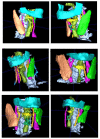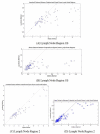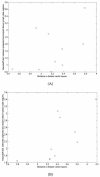Head and neck lymph node region delineation with image registration
- PMID: 20569461
- PMCID: PMC2902481
- DOI: 10.1186/1475-925X-9-30
Head and neck lymph node region delineation with image registration
Abstract
Background: The success of radiation therapy depends critically on accurately delineating the target volume, which is the region of known or suspected disease in a patient. Methods that can compute a contour set defining a target volume on a set of patient images will contribute greatly to the success of radiation therapy and dramatically reduce the workload of radiation oncologists, who currently draw the target by hand on the images using simple computer drawing tools. The most challenging part of this process is to estimate where there is microscopic spread of disease.
Methods: Given a set of reference CT images with "gold standard" lymph node regions drawn by the experts, we are proposing an image registration based method that could automatically contour the cervical lymph code levels for patients receiving radiation therapy. We are also proposing a method that could help us identify the reference models which could potentially produce the best results.
Results: The computer generated lymph node regions are evaluated quantitatively and qualitatively.
Conclusions: Although not conforming to clinical criteria, the results suggest the technique has promise.
Figures









Similar articles
-
Head and neck lymph node region delineation with 3-D CT image registration.Proc AMIA Symp. 2002:767-71. Proc AMIA Symp. 2002. PMID: 12463928 Free PMC article.
-
Combining registration and active shape models for the automatic segmentation of the lymph node regions in head and neck CT images.Med Phys. 2010 Dec;37(12):6338-46. doi: 10.1118/1.3515459. Med Phys. 2010. PMID: 21302791 Free PMC article.
-
Head and neck nodal station images: guidance for three-dimensional radiation therapy treatment planning.J Digit Imaging. 2002 Dec;15(4):240-6. doi: 10.1007/s10278-002-0034-3. Epub 2003 Jan 21. J Digit Imaging. 2002. PMID: 12532256 Free PMC article.
-
Guidelines for the delineation of nodal regions of the head and neck on axial computed tomography images.Tumori. 2002 Sep-Oct;88(5):355-60. doi: 10.1177/030089160208800501. Tumori. 2002. PMID: 12487550 Review.
-
Ultrasonography of abnormal neck lymph nodes.Ultrasound Q. 2007 Mar;23(1):47-54. doi: 10.1097/01.ruq.0000263839.84937.45. Ultrasound Q. 2007. PMID: 17558229 Review.
Cited by
-
Biological Model Development as an Opportunity to Provide Content Auditing for the Foundational Model of Anatomy Ontology.AMIA Annu Symp Proc. 2015 Nov 5;2015:2111-20. eCollection 2015. AMIA Annu Symp Proc. 2015. PMID: 26958311 Free PMC article.
-
Towards automated planning for unsealed source therapy.J Appl Clin Med Phys. 2012 Jul 5;13(4):3789. doi: 10.1120/jacmp.v13i4.3789. J Appl Clin Med Phys. 2012. PMID: 22766948 Free PMC article.
-
Multi-atlas segmentation of biomedical images: A survey.Med Image Anal. 2015 Aug;24(1):205-219. doi: 10.1016/j.media.2015.06.012. Epub 2015 Jul 6. Med Image Anal. 2015. PMID: 26201875 Free PMC article. Review.
-
Multiatlas segmentation of thoracic and abdominal anatomy with level set-based local search.J Appl Clin Med Phys. 2014 Jul 8;15(4):4468. doi: 10.1120/jacmp.v15i4.4468. J Appl Clin Med Phys. 2014. PMID: 25207393 Free PMC article. Clinical Trial.
-
Deep learning for automatic head and neck lymph node level delineation provides expert-level accuracy.Front Oncol. 2023 Feb 16;13:1115258. doi: 10.3389/fonc.2023.1115258. eCollection 2023. Front Oncol. 2023. PMID: 36874135 Free PMC article.
References
-
- International Commission on Radiation Units and Measurements. Prescribing, Recording and Reporting Photon Beam Therapy. Bethesda, MD, International Commission on Radiation Units and Measurements, Report 50; 1993.
-
- International Commission on Radiation Units and Measurements. Prescribing, Recording and Reporting Photon Beam Therapy (Supplement to ICRU Report 50) Bethesda, MD, International Commission on Radiation Units and Measurements, Report 62; 1999.
-
- Chao KSC, Wippold FJ, Ozyigit F, Tran BN, Dempsey JF. Determination and Delineation of Nodal Target volumes for Head-and-Neck Cancer Based on Patterns of Failure in Patients Receiving Definitive and Postoperative IMRT. Int Journal of Radiation Oncology Biol Phys. 2002;53:1174–1184. doi: 10.1016/S0360-3016(02)02881-X. - DOI - PubMed
-
- Teng C, Shapiro LG, Kalet IJ. Automatic segmentation of neck CT images. Proc. 19th IEEE International Symposium on Computer-Based Medical Systems. 2006. pp. 442–445. full_text.
MeSH terms
LinkOut - more resources
Full Text Sources
Medical

